Protecting concrete in cold weather is a continuous challenge for concrete contractors and site supervisors. Placing concrete in the cold weather condition requires special preparation and protection. All necessary precautions should be taken in order to to alleviate the negative impacts of cold weather. Special curing and protection is required in most cases. In my previous article, we reviewed what is considered cold for concrete construction, and what should be done prior to placing concrete. In this article, I will review some of the widely used protection techniques and strategies and the challenges in protecting the concrete from extreme cold. But first, let’s see what cold means for concrete:
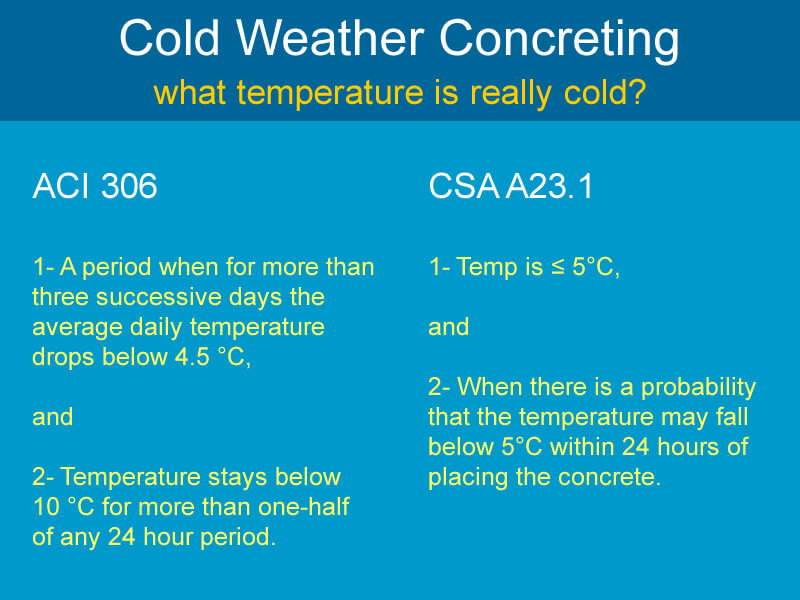
Why Cold Temperature is critical
The hydration of cement is a chemical reaction. Extremely low temperatures as well as freezing can significantly slow down the reactions, thus, affecting the strength growth. In fact, freezing temperatures within the first 24 hours (or when concrete is still in plastic state), can reduce the strength by more than 50%.
Protecting Concrete in Cold Weather
The CSA A23.1 specifies that protection shall be provided by means of:
1) Heated enclosures
2) Coverings
3) Insulation
The protection should be continued until required structural properties such as strength is achieved. The minimum strength before exposing concrete to extreme cold is 500 psi (3.5 MPa). CSA A 23.1 specified a compressive strength of 7.0 MPa to be considered safe for exposure to freezing. Traditionally, cast-in-place punch out cylinders are used to estimate the strength at certain intervals. The maturity method is gaining popularity with the recent advancement in wireless sensor technology. Wet curing during this period should be avoided.
Covering – Curing Blankets w/o Insulation
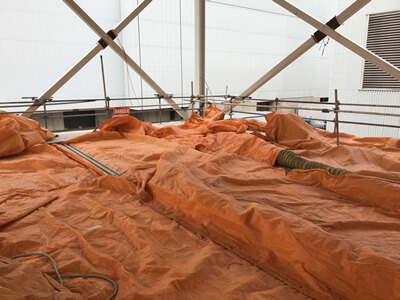 Covering with curing blanks is widely used in construction sites during the cold season. The heat generated from the hydration of cement is normally sufficient for many cases, should blankets are used properly. Blankets should remain for a couple of days. The required insulating value depends on the thickness of concrete, the amount of cement, and anticipated cold temperature. Consult ACI 306 chapter 7 for details on the insulation.
Covering with curing blanks is widely used in construction sites during the cold season. The heat generated from the hydration of cement is normally sufficient for many cases, should blankets are used properly. Blankets should remain for a couple of days. The required insulating value depends on the thickness of concrete, the amount of cement, and anticipated cold temperature. Consult ACI 306 chapter 7 for details on the insulation.
Site managers, and engineers are responsible to assess if concrete has reached desired strength. Temperature monitoring using infrared thermography from concrete surface or maturity method can be used for better decision making.
The heat generated from hydration process should suffice in most cases, if appropriate insulating blankets of polyethylene sheets are used. Additional source of heat might be required based on area and temperature.
When covering with blankets, special attention should be given to the corners and edges of the slabs. These area often require further insulating layers. If covering can not keep the concrete temperature at desired levels, external heat source such as electric heating blankets, or hydronic heating pipes should be used.
Heated Enclosures
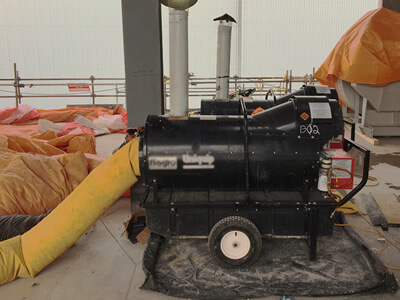 If blankets do not provide enough protection, or if the weather is extremely cold (even prior to placing concrete), then heated enclosures should be used. This technique includes enclosing the construction site (for example the storey under construction), and heating the space. Certain challenges should be addressed:
If blankets do not provide enough protection, or if the weather is extremely cold (even prior to placing concrete), then heated enclosures should be used. This technique includes enclosing the construction site (for example the storey under construction), and heating the space. Certain challenges should be addressed:
1- Carbon Dioxide-Carbonation
One common challenge with heated enclosure is the problem of carbonation. The carbon-dioxide produced by some of commercially available heaters increases the chance of carbonation of freshly placed concrete. This can lead to formation of a weak concrete layer which is often unacceptable. It is recommended to use heating systems that exhaust to the outside of the enclosure.
2- Rapid Drying / Uneven Heating
The use of heaters can result in very rapid drying of concrete, which will increase the chance of plastic shrinkage, and might lead to poor quality concrete (if water required for hydration process evaporates). It is recommended to move the location and direction of heat source for a more uniform heating pattern.
3- Fire
Special attention should be paid to the heaters that use propane gas.


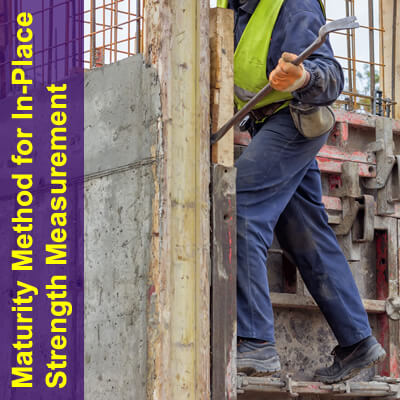


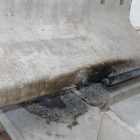
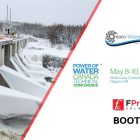
Rafid Attrah
Thanks for this details, and really I would like to ask
If we go to use just a covering of concrete which is economic for small project , what does the cooler temperature possible ? is it between 5 to -5 c or higher
Hiba Nofal
Thanks for valuable article 👍
Kevin W. Smith
Very good summary. In the US, it is easy to forget that many engineers and construction contractors deal with cold weather for much of the year.
Frank Kozeliski
I wish the temperatures were in F degrees. and strength was in PSI.
Have you studied the new ACI 306R-16. The ACI university has a seminar on the new Guide which is in non-mandatory language.
example: 500 psi strength is sufficient to prevent damage from a single freeze/thaw event (air -entrained Concrete)
FPrimeC
Please read here: https://fprimec.com/cold-weather-concreting
Humphrey
Thanks for this insightful article. When using heated enclosure in cold weather concreting, what specific temperature should be maintained to avoid carbonation and rapid drying/uneven heating?
Boy-Arne Buyle
I live and work in the Norwegian Artic city of Narvik and am the laboratory leader at the University. Heatwork has developed a system that let's us work all year through with documented quality see link below https://heatwork.com/en/products/concrete-systems/
Harry Moats
Good article with good information especially this time of year but seldom followed. No one wants to pay for the protection but they want their concrete poured leaving the concrete contractor with the liability if something goes wrong.
Vladimir
Heated enclosures.
A heating cable fixed into concrete can be used.